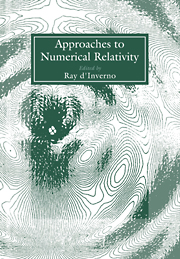Book contents
- Frontmatter
- Contents
- Contributors
- Introduction
- Preface
- PART A THEORETICAL APPROACHES
- PART B PRACTICAL APPROACHES
- Numerical asymptotics
- Instabilities in rapidly rotating polytropes
- Gravitational radiation from coalescing binary neutron stars
- “Critical” behaviour in massless scalar field collapse
- Godunov-type methods applied to general relativistic stellar collapse
- Astrophysical sources of gravitational waves and neutrinos
- Gravitational radiation from 3D gravitational stellar core collapse
- A vacuum fully relativistic 3D numerical code
- Solution of elliptic equations in numerical relativity using multiquadrics
- Self-gravitating thin discs around rotating black holes
- An ADI scheme for a black hole problem
- Time-symmetric ADI and causal reconnection
- The numerical study of topological defects
- Computations of bubble growth during the cosmological quark-hadron transition
- Initial data of axisymmetric gravitational waves with a cosmological constant
- PANEL DISCUSSION
Initial data of axisymmetric gravitational waves with a cosmological constant
Published online by Cambridge University Press: 15 December 2009
- Frontmatter
- Contents
- Contributors
- Introduction
- Preface
- PART A THEORETICAL APPROACHES
- PART B PRACTICAL APPROACHES
- Numerical asymptotics
- Instabilities in rapidly rotating polytropes
- Gravitational radiation from coalescing binary neutron stars
- “Critical” behaviour in massless scalar field collapse
- Godunov-type methods applied to general relativistic stellar collapse
- Astrophysical sources of gravitational waves and neutrinos
- Gravitational radiation from 3D gravitational stellar core collapse
- A vacuum fully relativistic 3D numerical code
- Solution of elliptic equations in numerical relativity using multiquadrics
- Self-gravitating thin discs around rotating black holes
- An ADI scheme for a black hole problem
- Time-symmetric ADI and causal reconnection
- The numerical study of topological defects
- Computations of bubble growth during the cosmological quark-hadron transition
- Initial data of axisymmetric gravitational waves with a cosmological constant
- PANEL DISCUSSION
Summary
Abstract. We investigate initial data for localized gravitational waves in space-times with a cosmological constant Λ. By choosing the appropriate extrinsic curvature, we find that the Hamiltonian and momentum constraints turn out to be the same as those of the time-symmetric initial value problem for vacuum space-times without Λ. As initial data, we consider Brill waves and discuss the cosmological apparent horizon. Just as with Brill waves in asymptotically flat space-time, the gravitational “mass” of these waves is positive. Waves with large gravitational mass cause a strong cosmic expansion. Hence, the large amount of gravitational waves do not seem to be an obstacle to the cosmic no-hair conjecture.
INTRODUCTION
The present isotropy and homogeneity of our universe is something of a mystery within the framework of the standard big bang scenario. The inflationary universe scenario, however, is one of the favourable models which may explain the so-called homogeneity problem [1]. In this scenario, when a phase transition of the vacuum occurs due to an inflaton scalar field and supercooling results, the vacuum energy of the scalar field plays the role of a cosmological constant and the space-time behaves like the de Sitter one with a rapid cosmic expansion. This phenomenon is called inflation. As a result, all inhomogeneities go outside the horizon by rapid cosmic expansion. After inflation, the vacuum energy of the scalar field decays into radiation and the standard big bang scenario is recovered. However, there still remains a question in the above scenario.
Information
- Type
- Chapter
- Information
- Approaches to Numerical Relativity , pp. 345 - 352Publisher: Cambridge University PressPrint publication year: 1992
